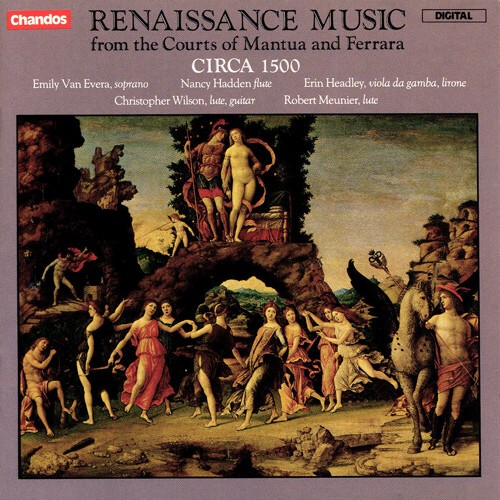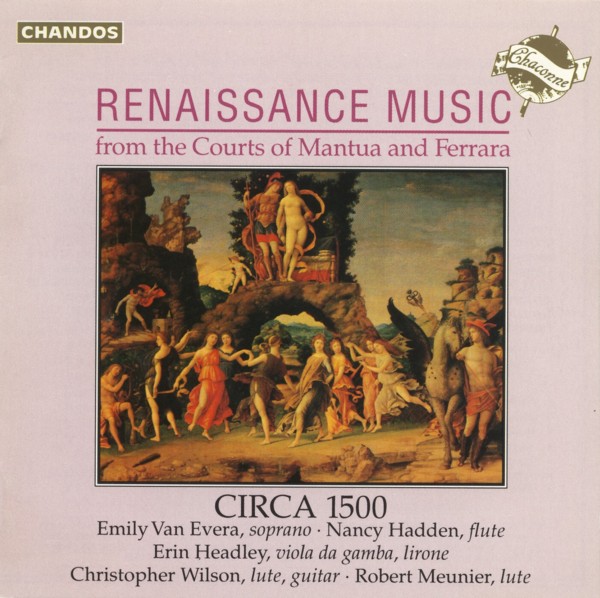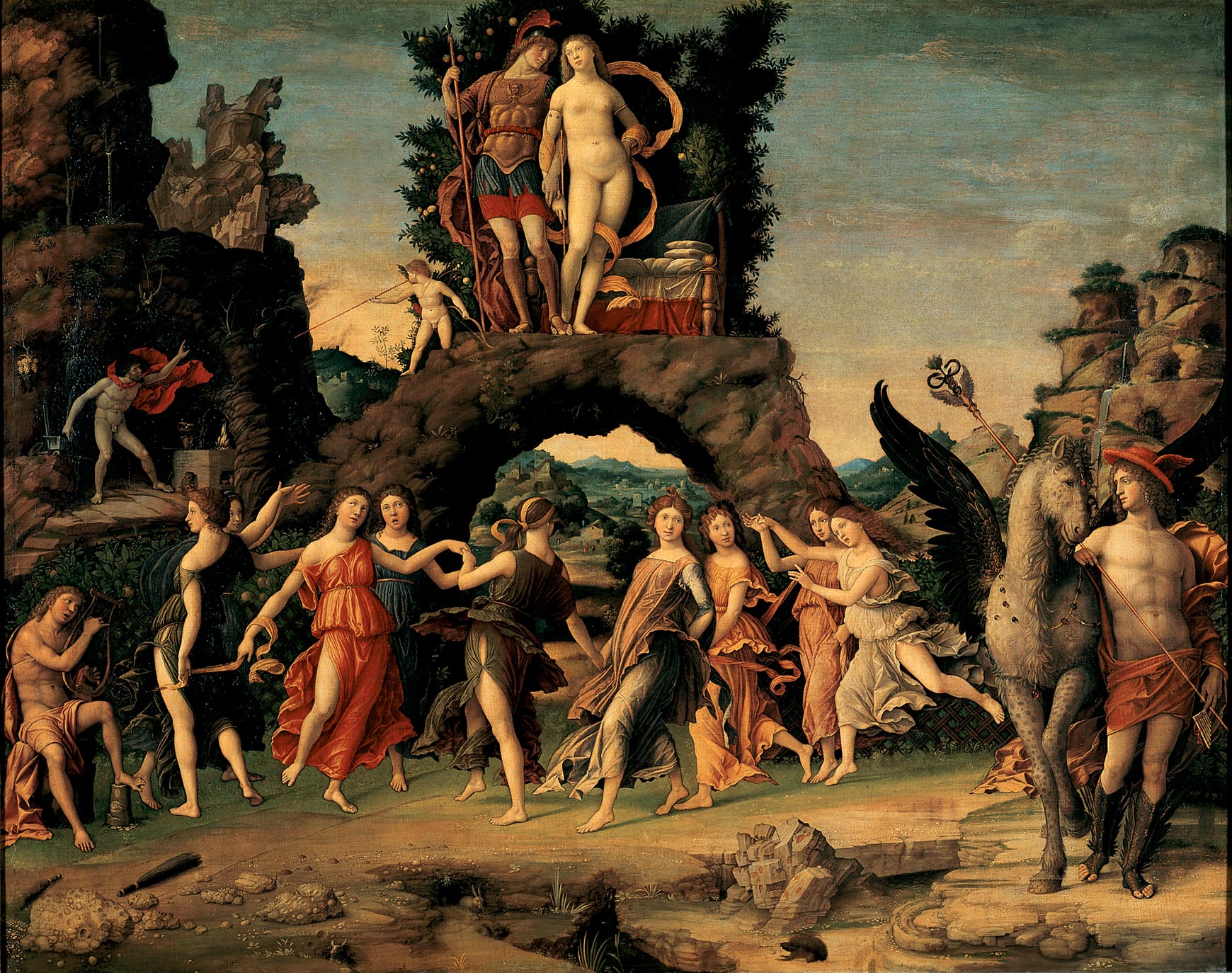Renaissance Music from the courts of Mantua and Ferrara
Circa 1500

medieval.org
© 1984 — Chandos 8333
© 1991 — Chandos Chaconne 0524
℗ 1984
1. Marchetto CARA. Mal un muta per effecto [3:12]
barzelletta
2. Bartolomeo TROMBONCINO. Vale diva, vale in pace [4:38]
barzelletta
3. Saltarello, Baxela un tratto [0:52]
instrumental dance
4. Marchetto CARA. Bona dies, bona sera [1:12]
barzelletta
5. Francesco SPINACINO. Ricercare [1:20]
lute
6. Marchetto CARA. O mia cieca e dura sorte [7:12]
barzelletta
7. Calata [1:58]
lute
8. Marchetto CARA. Aimè, ch'io moro [3:31]
strambotto
9. Bartolomeo TROMBONCINO. Poi che volse la mia stella [4:05]
barzelletta
10. DIOMEDES. Dolores mortis [1:44]
lauda
11. Bartolomeo TROMBONCINO. Virgine bella [4:09]
lauda
12. Se mai per maraveglia [6:38]
capitolo
13. Saltarello, El marchese di Saluzzo [1:41]
instrumental dance
14. Eustachio ROMANO. Cantus cum tenor [1:43]
instrumental duo
15. Chui dicese non l'amare [3:01]
frottola
16. Bartolomeo TROMBONCINO. Ostinato vo' seguire [2:44]
barzelletta
17. Pavana, La cornetta [2:14]
instrumental dance
18. Marchetto CARA. Hor vendut'ho la speranza [3:00]
barzelletta
Circa 1500
Emily Van Evera, soprano
Nancy Hadden, flute
Erin Headley, viola da
gamba, lirone
Christopher Wilson, lute,
guitar
Robert Meunier, lute
CIRCA
1500 is a mixed consort devoted, as its name suggests, to performing
the music of the Renaissance, especially that of the late fifteenth and
early sixteenth centuries. The members of CIRCA 1500 are all specialists
in the field of early music. Their individual knowledge and performing
experience has enabled the group to develop a polished and exuberant
style which is based on a study of historical sources and instruments.
Since the group began in 1982 they have been active as a touring and
recording ensemble, with numerous engagements in Europe and Great
Britain.
A Chandos Digital Recording
Recording Producer: Brian Couzens
Sound Engineer: Ralph Couzens
Assisting Engineer: Bill Todd
Recorded in the Church of St. Barnabas, North Finchley, London in September 1983
Front Cover Painting: "Parnassus" by Andrea Mantegna, courtesy of Louvre/Lauros-Giraudon
Sleeve Design: Gary Thorpe

The
arrival in 1490 of Isabella d'Este (1474-1539) at the court of Mantua
as the bride of Francesco Gonzaga (1466-1519) marked the awakening of a
new era in Italian music. Whereas the musical life at Mantua and other
courts of northern Italy had previously reflected the prevailing taste
for Franco-Flemish music, Isabella commissioned both poetry and music by
native Italians, resulting in a musical idiom whose roots lay in the
popular performing practice of declaiming poetry to the accompaniment of
a lira da braccio or lute. The artistic climate created by her patronage fostered the development of the frottola,
the genre of Italian song that flourished during the decades either
side of 1500. The musical developments at Mantua soon spread to other
courts, and those composers and performers who excelled in the new style
were much sought after throughout the north of Italy.
Marchetto
Cara and Bartolomeo Tromboncino, two of the most highly esteemed
musicians of their day, are known to us as the outstanding composers of frottole.
Tromboncino (c1470-c1535) was the most prolific of the frottolists. He
was in service at Mantua from 1494 until sometime between 1502 and 1506,
travelling often to other courts. He was greatly valued by Isabella and
Francesco, in spite of his stormy nature. His most notorious act was
that of murdering his wife, Antonia "with great cruelty... for having
found her at home alone in a room with Zoanmaria de Triomfo", an offence
to which Isabella responded by imploring Francesco to have mercy. He
also fled Mantua at least twice without permission. After one such
flight in 1501, Francesco wrote angrily that Tromboncino had left
despite "having been better paid by us, and having been given more
favours, kindnesses, and liberties than any other of our courtiers". Yet
they chose to overlook each offence, perhaps because of Tromboncino's
invaluable contribution to the musical life — and thereby the prestige —
of the Mantuan court. He entered the service of Lucrezia Borgia at
Ferrara in 1506, where he remained as late as 1513, after which little
is known of him. His epitaph contains the following lines:
"Who will now sing to us with a divine voice?
Who will compose with such celestial notes?
Who will play with such a sonorous lira?"
Marchetto
Cara (1465-1525) "following in the footsteps of Josquin, taught the
world how to compose music." Cara enjoyed a long and stable career at
Mantua, beginning his service there in 1494 and remaining throughout his
life. In addition to his responsibilities as maestro di cappella,
he performed as a singer and lutenist at courts throughout the north of
Italy, often with his wife, the singer Giovanna Moreschi. We learn
something of Cara's musical nature in a passage from Baldassare
Castiglione's Il Cortegiano (1528):
"Consider music, the
harmonies of which are now solemn and slow, now very fast and novel in
mood and manner. And yet all give pleasure, although for different
reasons, as is seen in Bidone's manner of singing which is so full of
artifice, so quick, vehement, impassioned and has such various melodies
that the spirits of his listeners are stirred and catch fire, and are so
entranced
that they seem to be lifted upwards to heaven. No less moving in his
singing is our Marchetto Cara, only with a softer harmony, for in a
manner serene and full of plaintive sweetness he touches and enters our
souls, gently impressing a delightful passion upon them."
The
music of the frottolists reflected the aims of contemporary humanism in
its attentiveness to poetic form and rhythm. It was believed that the
classical Greeks had attained a perfect unity of poetry and music, and
this the Italians also sought to achieve. Of the Italian poetic forms
set to music the barzelletta was most favoured, and other forms included the strambotto, oda, capitolo, sonnet and canzone. The poetry ranges from Petrarch's inspired and exquisite verse to delicately fashioned amorous texts and rough-hewn barzellette. Laude were composed to devotional texts, often in Latin, sung on feast days or as part of religious plays.
The origins of the two anonymous vocal works, each highly distinctive, can only be speculated upon. Se mai per maraveglia
is unique in both musical style and subject. A dramatic evocation of
the passion of Christ, it may have been sung as part of a sacred play. Chui dicese non l'amare is one of four pieces printed in Petrucci's Frottole Libro Sexto
(1505) which are striking for their highly melismatic vocal lines and
cadential dissonances. The texts of two are by the renowned
poet-improviser Leonardo Giustiniani (c1383-1446), and Chui dicese and its companion pieces may be written examples of his improvisational style.
The rise of the frottola was due in large part to the enterprising efforts of the Venetian publisher Ottaviano Petrucci. His first book of frottole
was offered to the public in 1504, followed by ten more books in rapid
succession until 1514. Rival publishers in Rome, Siena and Naples
followed Petrucci's lead with fifteen collections of frottole between 1510 and 1531, spreading the wealth of new music to all parts of Italy.
The variety of instrumentation represented in pictorial and musical sources suggests that the frottola
was performed in many different ways. Petrucci published arrangements
for voice and lute (1509, 1511, 1520), and intabulations for solo
keyboard and for lute were also published. Mixed consorts of two lutes,
bowed strings and winds were often depicted in Italian paintings of the
period, and accounts of musical evenings at the Este and Gonzaga palaces
affirm that the Italians enjoyed a wide spectrum of instrumental
colours and combinations, ranging from solo singing accompanied by a
single lute or lira de braccio to consorts, both like and mixed, of winds and strings. Of special interest on this recording is the use of the lirone, the larger relative of the seven-stringed lira da braccio. The lirone is distinguished from the lira da braccio
not only by its larger size but also by its greater number of strings
and unique tuning which allows the bowing of full sustained chords. The lirone corresponds to a lira which the poet-improviser Atalante Migliorotti described in a letter to Francesco Gonzaga in 1505:
"With my modest ability I am introducing a new, unheard and unknown method of playing with a new and unknown type of lira.
I shall add strings so that there are twelve, some attached to the
tail-piece and some on the fingerboard, in perfect and consummate
harmony."
The earliest publication of lute music, Francesco Spinacino's Intabulatura de Lauto (1507), contains settings of chansons, dances and ricercari in an idiomatic style which represents a tradition of lute ornamentation and improvisation practiced by players of the time. Ricercari
were often played as preludes to more extended vocal or instrumental
compositions. The Thibault lute manuscript incorporates a prelude and
interludes in the lute accompaniment to Vale diva. The Calata is from the same source. The duo cantus cum tenor comes from Musica Duorum (Rome, 1521), a collection of forty-five textless duets, or bicinia by the frottola composer Eustachio Romano.
Italian dance music was popular throughout Europe during the sixteenth century. The new pavane, gagliarde and saltarelli
were included in virtually every collection of lute music. Ensemble
settings are rare, although a few manuscript sources preserve four-part
settings. These dances superseded the fifteenth-century basse danse at the time when the growing taste for frottole
ousted the Franco-Flemish chanson. The new Italian dances with their
tuneful melodies (often adapted from popular songs such as El Marchese di Saluzzo), well-defined phrases, and strong harmonic character have much in common with the frottola style.
The painting reproduced on the cover, Parnassus by Andrea Mantegna, was especially commissioned by Isabella d'Este for her private studiolo and completed in 1497. Parnassus
is rich in its allusions to music. The nine Muses dance and sing in the
centre. Apollo, the god of music, sings to his lyre; Mercury holds his
panpipes. Sacred springs whose waters give poetic inspiration flow from
under the hoof of Pegasus. There is an exchange between Vulcan (who as
Tubal Cain took part in Jubal's discovery of the laws of harmony) and
Amor, whom Plato deemed "a composer so skilled that he is the cause of
composing in others." Presiding over all are Mars and Venus, who can be
viewed as symbolic representations of Francesco and Isabella, peacefully
united above a harmonious world in which the arts, and above all music,
flourish.
Nancy Hadden and Emily Van Evera



